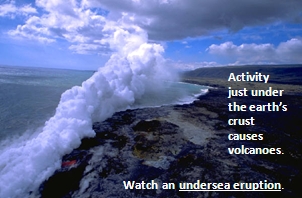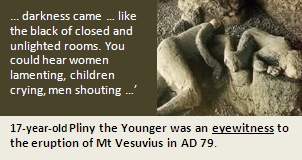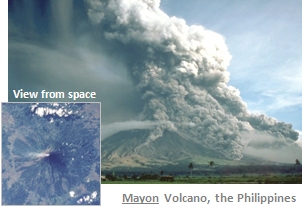Volcanoes
|
|
Links
- http://en.wikipedia.org/wiki/Volcano
- https://youtu.be/hmMlspNoZMs
- https://www.nationalgeographic.com.au/videos/101-videos/volcanoes-101-4686.aspx
- https://www.nationalgeographic.com.au/videos/highlights/volcanoes-3667.aspx
- http://en.wikipedia.org/wiki/Pyroclastic_flow
- http://en.wikipedia.org/wiki/Mt._Mayon
- https://earthquakes.volcanodiscovery.com/
- http://www.bbc.co.uk/science/earth/collections/mount_vesuvius
- http://www.britishmuseum.org/whats_on/exhibitions/pompeii_and_herculaneum/pompeii_live/eruption_timeline.aspx
- https://interactive.archaeology.org/pompeii/history.html
- http://en.wikipedia.org/wiki/Mt._Vesuvius
- http://en.wikipedia.org/wiki/Mayon_Volcano
- http://en.wikipedia.org/wiki/List_of_volcanoes_in_Australia
- https://mapmaker.nationalgeographic.org/#/
- https://www.google.com/maps/@-26.4684206,136.4678036,5180211m/data=!3m1!1e3!5m1!1e4
- https://www.nationalgeographic.org/encyclopedia/volcano/
- https://volcano.si.edu/volcano.cfm?vn=234011
- http://www.abc.net.au/news/2016-02-01/scientists-witness-big-ben-volcano-erupting-remote-heard-island/7130556
- http://www.volcanolive.com/australia.html
- https://blog.csiro.au/rv-investigator-discovers-a-50-million-year-old-volcano-cluster-off-the-coast-of-sydney/
- https://www.stuffyoushouldknow.com/podcasts/how-volcanoes-work.htm
- http://education.abc.net.au/home#!/media/1481497/piecing-together-the-puzzle-of-plate-tectonics
- https://www.nationalgeographic.org/media/plate-tectonics/
- http://www.ga.gov.au/scientific-topics/hazards/volcano
- https://volcanoes.usgs.gov/vhp/edu_resources.html
- https://app.education.nsw.gov.au/rap/resource/access/d7c073b8-14e8-4fb9-afc7-a17e19b83115/1











